#that i 'have a true talent for written visual analysis' and to 'take her word on it'
Explore tagged Tumblr posts
Text
a lot of my teachers this year have randomly complimented me on my writing even when the class largely has nothing to do with it and tbh??!??! it's really nice and it makes me want to write more?!?!?!!?!?!
#i thought i was bad at it but i think it's just bc i had to write so many academic essays that i stopped having time for creative writing#but i was shocked today because i had a one-on-one with my painting teacher which was basically my final#it wasn't even a crit just a talk basically about my painting#and i had to submit a write-up in advance about what i learned through the process of that class basically#so anyway when i got to the one-on-one the first thing he did was thank me for the write-up and he was like 'clearly you love writing'#'you're a good writer'#and i was like what!?!?!??!?!?#BECAUSE#im not trying to brag SERIOUSLY but i wrote it really fast and i didn't think it was that crazy#but it meant a lot coming from him because he's probably the most articulate and insightful teacher i've ever had#and also he like has a degree in english LOL#and he said i was a storyteller... so anyway..... i almost cried in the club immediately#well anyway. top ten moments#also my art history professor who i deeply respect wrote a very thoughtful comment on my work today to tell me that she thinks#that i 'have a true talent for written visual analysis' and to 'take her word on it'#BOTH OF THESE MOMENTS?? IN THE SAME DAY?!??!!?!#sorry for 18 paragraphs of bragging but i was truthfully floored#i am always floored when people compliment my writing because lowkey i am hugely insecure about it and feel like i can't articulate shit#like so insecure i cant even write lyrics for songs im like 'i have nothing to write about' man stfu just make shit up its called FICTION#anyway....#top ten days of my life
4 notes
·
View notes
Text
What to expect ahead of the July 15th premier -- a theory recap and a brief guide to analysis.
With the premier of season three of Star vs. the Forces of Evil a mere week and a half away, I thought that now might be good to talk about what to expect. This will not be a prediction post per se -- instead, I’d like to highlight some of the meaningful patterns from previous episodes, discuss how they might be relevant to the upcoming movie on July 15th, and, in so doing, establish some loose guidelines for us, the audience, to make sense of any hidden layers of meaning in the movie.
Before we get to the meat of this post, I’d like to revisit some of my best theories and offer links to them. These are the posts that I think reflect my best work and contain ideas relevant to the upcoming season.
Theory Recap
Star vs. the Forces of Evil and the Holy Grail: Subtle hints throughout the series foreshadow the appearance of a literal Holy Grail at some point -- probably in the form of Lekmet’s horn.
Toffee as Sauron: Toffee’s missing finger, Moon’s tapestry, and some cunning wordplay all point toward Toffee being inspired in part by the Lord of the Rings himself.
The Limits of Violence: As a seasoned warrior, Toffee won’t be defeated through violence alone. Star will have to use her creative ingenuity and spontaneity to bring about his downfall.
Star as Venus: Star’s ability to use both light and dark magic -- and combine them -- hints at her real identity as Venus, the morning and evening star.
Metaphorical Scissors: The idea that a pair of scissors metaphorically represents a couple is widespread, and the series incorporates this idea regarding Star, Marco, and their dimensional scissors.
Those are the theories that I think will be most relevant to the upcoming movie -- but I invite you to check out the others in my archive as well.
A Brief Guide to Analysis
You’ll often hear it said that Star vs. the Forces of Evil is a board-driven (or storyboard-driven) cartoon. Yet I would argue that the writers wield an unusual amount of influence over the series, their ideas often overriding the storyboards in order to maintain an idiosyncratic and revelatory narrative that is consistent from episode to episode. I base this argument on the observations I’ve made while watching the series (which you can read in individual analyses on this blog). The following five points describe elements from the series that I believe reflect the extent of this intentional, grander scope:
Word choice. The writers are clearly careful with word choice; they often play with words, inserting subtle jokes, or use words unexpectedly.
Structure. The writers hide meaning in structure, such as how the different scenes of an episode are put together.
References. The writers use references to other works to give scenes additional meaning.
Symbolism. The writers repeatedly use objects, places, etc. to reinforce meaning.
Visual metaphor. Despite being related to symbolism, this probably deserves its own category; the writers use the composition and context of a shot to imply additional meaning.
I will go into each of these and give an example that I think best represents each element. Remember: my goal here is to show that Star vs. the Forces of Evil has an idiosyncratic grammar of meaning-making, and that you and I can not only study it but use it to grasp the hidden layers of meaning in upcoming episodes.
Word Choice
I get the impression from watching the series that words are extremely important to the writers of Star vs. the Forces of Evil. They pay close attention to dialogue, giving it not only verisimilitude but also refreshing and often surprising texture.
Too, the idea that magic and words are closely linked is an old one -- maybe as old as language itself -- and the series has been subtly hinting of its awareness of that connection. (I will one day write a full-length analysis discussing the importance of language to magic in Star vs. the Forces of Evil ... probably. It’s certainly a topic that needs discussing.) I fully expect the series to soon explore the nature of just what magic is.
But the single biggest clue, I think, that the writers are thinking about the meaning of words -- and how to use those words and what those words mean for the world that they’ve created -- is Glossaryck’s line at the end of “Storm the Castle”:
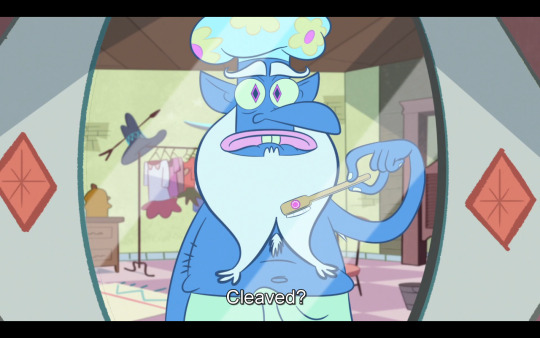
Glossaryck: Cleaved? Now that’s a funny word. You can cleave something apart, or you can cleave something together.
Much has been written about this line -- and not just by me! -- so I won’t go too far into those meanings here. This is just a brief guide, after all. But if you’ve been keeping up with analysis of the series, then you undoubtedly know just how much significance this line has ended up having.
By choosing cleaved as the crux of this line, the writers demonstrate a capacity for selecting words that are not only interesting but also have sounds, histories, and meanings which mimic and reinforce the story they want to tell -- without spelling out (so to speak) its meaning to the audience. That is the mark of talented and thoughtful writers.
Structure
An often-overlooked source of meaning in Star vs. the Forces of Evil is structure. I’ve yet to convince many people that February’s episode release was intentionally structured like a sonnet, but perhaps I can offer a better example to show what I mean: the structure of the season two finale.
In a previous post, I wrote that both “Face the Music” and “Starcrushed” are divided into eleven discrete chapters and that each of these chapters complement or contrast the corresponding scene from the other episode.
Why is the number eleven important? Simple: it’s the chapter, as revealed in “My New Wand!” -- the first episode of the season -- in Star’s journal which likely reveals her true feelings about Marco.
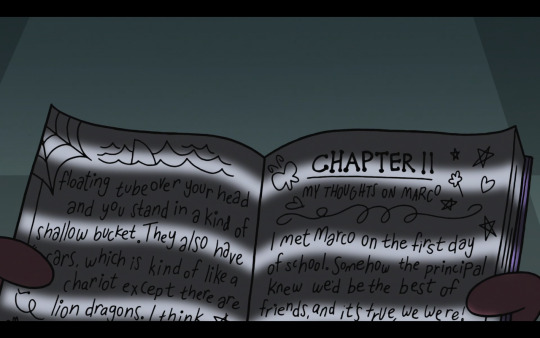
Appropriately enough, in the eleventh scene of both “Face the Music” and “Starcrushed,” Star’s feelings for Marco become revealed, first by Ruberiot and then by Star herself. The structure of these two episodes points back to the first episode of the season, thus confirming that, yes, in everything Star does during season two, her feelings toward Marco are always there in the background.
Thus, structure becomes a way for the writers to subtly reinforce meanings which they have already set in place.
References
The writers have clearly been influenced by popular media and often delight in inserting stealthy references whenever they can. One such reference from “Bon Bon the Birthday Clown,” is fairly obvious:
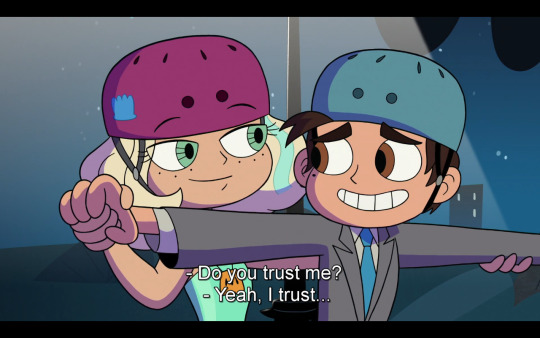
This scene is a (quite blatant) reference to a famous scene from the 1997 film Titanic -- in which a ship said to be unsinkable, well, sinks.
I’m sure you can draw your own conclusions as to what, if anything, the implications of this reference are (especially with regard to “shipping”). But my point is that the reference adds additional meaning to the scene, and this is quite intentional on the writers’ part.
Symbolism
I’ve written previously about the symbolism behind Star and Marco’s dimensional scissors. We first get an inkling of that symbolism in “Red Belt”:
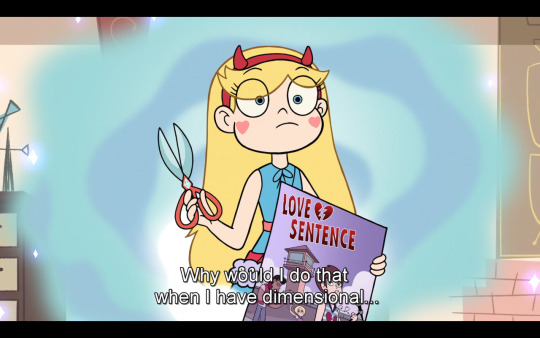
The scissors come to stand for Star and Marco together as a single pair. Indeed, not many people seem to be aware of this, but I actually wrote about the scissors symbolism prior to “Running with Scissors,” which, upon airing, indeed seemed to confirm my analysis:
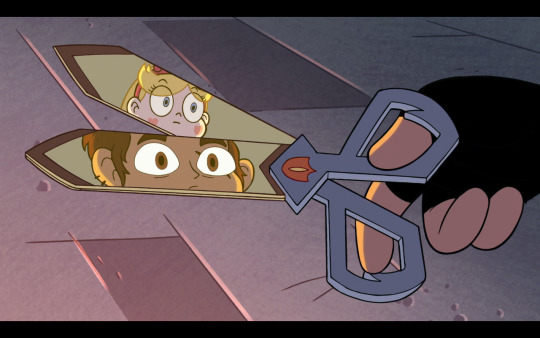
The idea behind symbols is actually quite simple, which makes them easy to spot: just look for something which is repeatedly shown, examine the contexts in which it is shown, and figure out what meanings can be derived from the relationship between its nature and its use.
For example, the dimensional scissors are what literally enable Star and Marco to be together, since otherwise they would be apart in their two separate worlds. And scissors are made of two separate things that are joined together (you might even say cleaved) in the center, which enables them to operate. Therefore, the scissors are symbolic of Star and Marco’s relationship.
As you can plainly see, “Running with Scissors” gives this analysis credence.
Visual Metaphor
I’ve often talked admiringly about the writers’ stunning use of visual metaphor. I would go so far as to say that they are completely unmatched in skill by any other recent Western animated series -- not even by BoJack Horseman, whose script is written about as tightly as modern animation is ever likely to get, or by Samurai Jack, whose visual style is simply staggering.
Visual metaphor is exactly what it says on the label: a metaphor conveyed visually.
The most potent visual metaphor so far in Star vs. the Forces of Evil comes near the end of “Bon Bon the Birthday Clown.” In fact, it was recognizing the genius of this visual metaphor which prompted me to start writing analysis for the series!
To understand the full visual metaphor, we need to have two things: the context of the scene and a grasp on Star’s feelings. The scene takes place after the battle with Ludo in which he steals Star’s spellbook. With this look on Star’s face, it is clear that she is emotionally devastated at not only having lost the book to Ludo but also having “lost” Marco to Jackie:
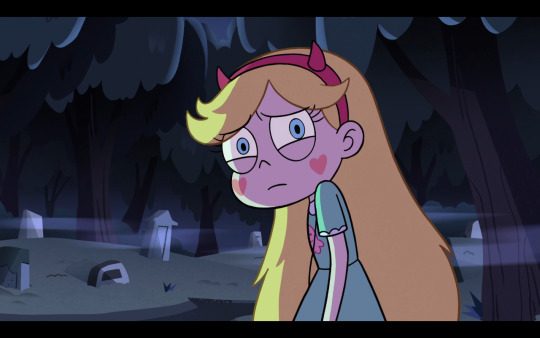
Star: I can’t believe Ludo took my spellbook. It’s got everything in it. That’s my whole family history. All the spells -- everything -- is lost! Marco: We’ll get it back. [Star begins to cry.] Star: I’ve lost Glossaryck! Marco: W-we’ll get him back, too. I promise.
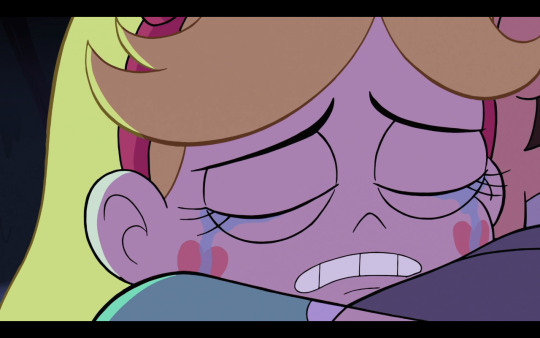
What Star says is that she’s lost Glossaryck -- that’s why she’s crying. But, as we can see from the scene, and as we know from earlier events, Star is pained at the prospect of having lost Marco’s affection. The hearts on Star’s face are cut in two by her tears. This is a plain visual metaphor: Star is broken-hearted.
Therefore, not only does this visual metaphor reveal something about Star’s true feelings, but the fact that she says something different from what is meant -- classic irony -- ratchets up the scene’s emotional tension: we know why Star is really crying, and it’s heartbreaking that she can’t tell anyone about it. She is utterly alone and broken. All of that is conveyed with one shot.
And that is visual storytelling at its finest.
Therefore...
I don’t know what “The Battle for Mewni” will be like, and I don’t think I could hazard any real guesses; however, if you and I keep these loose guidelines in mind as we watch it, we will, I believe, be able to discern the hidden layers of meaning that the writers seem to enjoy building into their show. That meaning is there, waiting for us to discover it.
One last thing: our goal should not be to tear the work apart but to appreciate it more completely -- to enrich what it means to us and, by so doing, enrich our own understanding of what meaning is and how to make it. If you’re trying to figure out how to construct art that intelligibly communicates meaningful human experience in a poetical mode -- that is, to say something without saying it -- you could do a hell of a lot worse than to study the writers behind Star vs. the Forces of Evil.
I hope you enjoyed this post. As usual, feel free to ask me questions or submit suggestions for future topics. Let’s look forward together to the return of Star vs. the Forces of Evil on July 15th!
122 notes
·
View notes
Text
Preface
Novels are written for people. Novels are about people.
Novels are about the personalities and feelings of one person or several; a group of people or hundreds and thousands. Their personalities and emotions are reflections of their environments, their experiences, and their interactions with other people. Virtually the only full-length novel revolving around a single person is Robinson Crusoe, which is about man's relationship with nature. But in the end, another person appears - the servant Friday. Having a single main character is more often seen in novellas. Often, they use man's interaction with his environment to demonstrate something about his external reality or internal world - especially the latter.
In the Western tradition of literary discourse, novels are analysed in three ways: by their settings, their characters, and their plots. Each author will place a different emphasis on each of these, depending on his or her own personality and talent.
Fundamentally, wuxia novels are similar to other novels in that they concern people. It is just that they are set in ancient times, the people know kungfu, and the plot tends to focus on exciting fight scenes. In that sense, any genre of novel will have its biases. Romance novels are about relationships between men and women - and sex. Realistic fiction describes a specific historical setting. Novels like the The Three Kingdoms and The Water Margin narrate the experiences of men at war. Contemporary novels often focus on the psychology of their characters.
Novels are a form of art. The fundamental content of art is human emotion, and the key thing that art seeks to demonstrate is beauty - beauty in a broad, aesthetic sense. In novels, beauty is found in word choice and sentence structure, with the crux being how the author is able to express the innermost thoughts of his characters. This can take any form; it can be seen in the subjective analysis of the author, or objectively shown in what characters do and say.
When someone reads a novel, a connection is forged between the novel's content and the state of the person’s own heart. One person may be powerfully moved by a novel; another person may be bored to tears by the same work. There is a "chemical reaction" between the reader's own personality and feelings, and what is demonstrated in the novel.
Wuxia novels are only one means of expressing human emotion. It is like a composer who, in attempting to express a certain feeling, makes use of the piano or violin, the orchestra or the choir. Similarly, the artist may choose to use oils or watercolours, inks or cartoons. The problem is not in the method chosen, but in whether or not they are able to express themselves through this medium - to forge a common connection between themselves and the reader, or listener, or viewer of art; to create a resonance with them. Novels are one of the many art forms, and there is good art, and there is bad art.
Whether something is good or bad has to do with its beauty, and not with its truth or goodness. And the standard for judging beauty is beauty - is emotion. We do not look at it as a scientist would, to see if it is true or false, or from a moralistic point of view, to see if it has virtue. Neither do we look at it from an economic point of view, to see if it is worth money, or as a ruler would, to see if it would benefit or harm governance. Of course, any type of art will have its impact on society, and it can be appraised by this impact - but that is another sort of assessment altogether.
Everything in medieval Europe was influenced by Christianity. That is why medieval artworks in museums all draw upon biblical themes. Even in representing the beauty of the female form, artists drew upon the image of the Madonna. This remained the case until the Renaissance, where representations of mortal men and women began to appear in art and literature. This so-called Renaissance was a revival of how the Greeks and Romans described “mankind”, and was no longer centered on the sacred and immortals.
In the Chinese tradition, the function of literature was to be “the vehicle of the Tao”. This was the case for a long time, and is similar to how Europe in the Dark Ages thought of literature. At that time, literature was measured by whether or not it had “virtue”. Love songs from the Book of Songs were explained - despite how far-fetched this may sound - as attempts to mock kings or serenade empresses. There were lovelorn lines from Tao Yuanming’s Ode to a Fantasy of Love, Sima Guang, Ouyang Xiu, Yan Shu. They also spoke regretfully of the flaws in a piece of white jade, or interpreted it in other ways. They did not believe that art and literature expressed emotion, and felt that the only function of words was in how they added value to governance or society.
In my wuxia novels, I merely create a few characters and describe what happens to them in a very specific wuxia environment (that is, an ancient, lawless society where martial skill was used to settle disputes). Society now is very different from what it was then, but the characters and emotions of people have not changed much. The joys and sorrows of people in ancient times can still elicit corresponding emotions from the modern-day reader. The reader may, of course, find the execution clumsy, the skill not fully mature, and the descriptions lacking in depth - from an artistic point of view, a decidedly lower-class work. But even so, I do not wish to be the vehicle for any sort of Tao. In writing my wuxia novels, I also write words of political commentary, and philosophy, and religion. What goes into the mind is up to the reader’s reason, and that is the only way you will be able to judge truth or falsehood. The reader may agree, or they may partially agree, or they may completely oppose me.
When it comes to novels, I hope that readers will only say whether they liked it or not, and whether they felt moved or were bored. My greatest joy is when a reader loves or hates the characters in my stories. If they feel this, it means that the characters have made a connection with the reader’s heart. The greatest desire of any author is nothing more than to create a few characters that become real in the reader’s heart - real as flesh and blood. Art is creation. Music creates beautiful sounds, painting creates beautiful visual images, and novels desire to create people. If all you wanted to do was to strictly reflect the real world, you have tape recorders and video cameras for that. Why do you need music and painting? When you have newspapers, history books, documentaries, social survey statistics, doctor’s records, personnel files from the police and the Party - why do you need novels?
Jin Yong, 6 Feb 1986
Hong Kong
1 note
·
View note